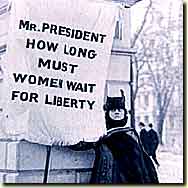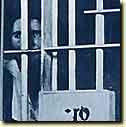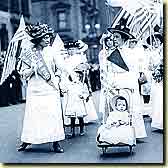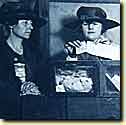Throughout the winter of 1917, Alice Paul and her followers in the National
Women's Party picketed the White House. They stood silently at the gates,
holding signs that said "Mr. president, how long must women wait for liberty?" The picketers
were suffragists. They wanted President Woodrow Wilson to support a
Constitutional amendment giving all American women suffrage, or the right to
vote.
 At first, the suffragists were politely ignored. But on April 6, 1917, the
United States entered World War I. The suffragists' signs became more pointed.
They taunted Wilson, accusing him of being a hypocrite. How could he send
American men to die in a war for democracy when he denied voting rights to
women at home? The suffragists became an embarrassment to President Wilson. It
was decided the picketing in front of the White House must stop.
At first, the suffragists were politely ignored. But on April 6, 1917, the
United States entered World War I. The suffragists' signs became more pointed.
They taunted Wilson, accusing him of being a hypocrite. How could he send
American men to die in a war for democracy when he denied voting rights to
women at home? The suffragists became an embarrassment to President Wilson. It
was decided the picketing in front of the White House must stop.
Spectators assualted the picketers, both verbally and physically. Police did
nothing to protect the women. Soon, the police began arresting the suffragists
on charges of obstructing traffic. At first, the charges were dropped. Next,
the women were sentenced to jail terms of just a few days. But the suffragists
kept picketing, and their prison sentences grew. Finally, in an effort to break
the spirit of the picketers, the police arrested Alice Paul. She was tried and
sentenced to 7 months in prison.
 Paul was placed in solitary confinement. For two weeks, she had nothing to eat
except bread and water. Weak and unable to walk, she was taken to the prison
hospital. There she began a hunger strike--one which others would join. "It
was," Paul said later, "the strongest weapon left with which to continue... our
battle . . ."
Paul was placed in solitary confinement. For two weeks, she had nothing to eat
except bread and water. Weak and unable to walk, she was taken to the prison
hospital. There she began a hunger strike--one which others would join. "It
was," Paul said later, "the strongest weapon left with which to continue... our
battle . . ."
In response to the hunger strike, prison doctors put Alice Paul in a
psychiatric ward. They threatened to transfer her to an insane asylum. Still,
she refused to eat. Afraid that she might die, doctors force fed her. Three
times a day for three weeks, they forced a tube down her throat and poured
liquids into her stomach. Despite the pain and ilness the force feeding caused,
Paul refused to end the hunger strike--or her fight for the vote.
 By the time Alice Paul was sent to prison, the fight for women's suffrage had
been going on for almost 70 years. It had started in 1848 in Seneca Falls, New
York, at a small Women's Rights Convention. These early feminists wanted the
same opportunities as men. They wanted the chance to attend college, to become
doctors and lawyers, and to own their own land. If they could win the right to vote,
they could use their votes to open the doors of the world to women.
By the time Alice Paul was sent to prison, the fight for women's suffrage had
been going on for almost 70 years. It had started in 1848 in Seneca Falls, New
York, at a small Women's Rights Convention. These early feminists wanted the
same opportunities as men. They wanted the chance to attend college, to become
doctors and lawyers, and to own their own land. If they could win the right to vote,
they could use their votes to open the doors of the world to women.
For the next 50 years, Elizabeth Cady Stanton and Susan B. Anthony led the
women's rights movement. Thanks to their efforts, the women's suffrage
amendment was presented to Congress for the first time in 1878. But Congressmen
refused to allow a vote on the issue. The amendment was reintroduced every year
for forty years. During that time, it was never voted upon.
By the time Alice Paul and the National Women's Party began their suffrage
campaign, the old leaders of the women's movement were gone. But support for
the suffrage amendment had grown. Women were already voting in twelve western
states. And in 1916, Jeannette Rankin of Montana became the first women elected
to Congress. Yet Congress was no closer to passing the suffrage amendment than
before.
 Paul was a veteran of suffrage protests. She had served a prison term in
Britain for supporting women's right to the vote. She and other younger leaders
like Harriet Stanton Blatch thought one last push was needed to get the
attention of the President and the Congress. Giant suffrage parades were held
in New York and Washington. Thousands of suffragists in long white dresses
marched. There were floats, women on horseback, and banners flying. A number of
men joined in. But the parades did not change the minds of President Wilson or
Congress. So the picketing began at the White House.
Paul was a veteran of suffrage protests. She had served a prison term in
Britain for supporting women's right to the vote. She and other younger leaders
like Harriet Stanton Blatch thought one last push was needed to get the
attention of the President and the Congress. Giant suffrage parades were held
in New York and Washington. Thousands of suffragists in long white dresses
marched. There were floats, women on horseback, and banners flying. A number of
men joined in. But the parades did not change the minds of President Wilson or
Congress. So the picketing began at the White House.
After 5 weeks in prison, Alice Paul was set free. The attempts to stop the
picketers had backfired. Newspapers carried stories about the jail terms and
forced feedings of the suffragists. The stories angered many Americans and
created more support than ever for the suffrage amendment.
 Finally, on January 9, 1918, WIlson announced his support for suffrage. The
next day, the House of Representatives narrowly passed the Susan. B. Anthony
Amendment, which would give suffrage to all women citizens. On June 4, 1919,
the Senate passed the Amendment by one vote. And a little more than a year
later, on August 26, 1920, Tennessee became the 36th state to ratify the
amendment. That made it officially the Nineteenth Amendment to the
Constitution.
Finally, on January 9, 1918, WIlson announced his support for suffrage. The
next day, the House of Representatives narrowly passed the Susan. B. Anthony
Amendment, which would give suffrage to all women citizens. On June 4, 1919,
the Senate passed the Amendment by one vote. And a little more than a year
later, on August 26, 1920, Tennessee became the 36th state to ratify the
amendment. That made it officially the Nineteenth Amendment to the
Constitution.
 American women at last had the right to vote. But Alice Paul and her colleagues
did not stop their campaign for women's rights. Instead, they began to push for
an Equal Rights Amendment to the Constitution, which would guarantee women
protection against discrimination. Some 80 years later, the battle for such an
amendment is still being fought.
American women at last had the right to vote. But Alice Paul and her colleagues
did not stop their campaign for women's rights. Instead, they began to push for
an Equal Rights Amendment to the Constitution, which would guarantee women
protection against discrimination. Some 80 years later, the battle for such an
amendment is still being fought.

